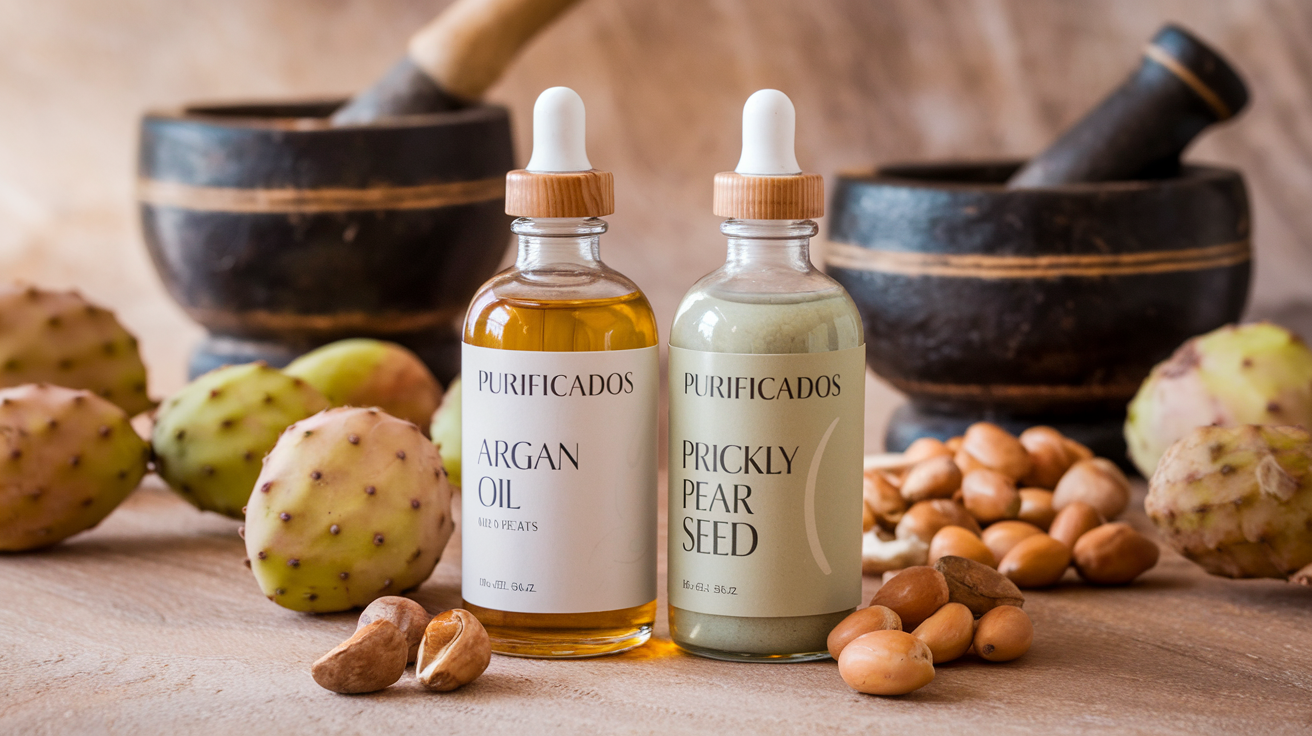
Understanding the origins and extraction methods of natural oils is key to appreciating their unique qualities and benefits. Both prickly pear seed oil and argan oil are derived from plants native to North Africa, with deep roots in traditional beauty practices. However, their distinct sources, extraction processes, and cultural significance set them apart in the world of natural oils.
Prickly Pear Seed Oil: Source, Harvesting, and Extraction Methods
Source and Origin:
Prickly pear seed oil, also known as barbary fig oil, comes from the seeds of the Opuntia ficus-indica cactus, a resilient plant native to Morocco and other regions of North Africa and the Mediterranean. The cactus thrives in arid climates, where it has adapted to survive in harsh conditions, making it a symbol of resilience and vitality.
Harvesting:
Harvesting prickly pear seeds is a labor-intensive process. The cactus produces fruits, commonly referred to as prickly pears, which are carefully hand-harvested to avoid the sharp spines covering the plant. Inside each fruit are small seeds, and it takes a staggering amount of seeds—approximately 1 ton of fruit—to produce just one liter of oil. This is one of the reasons prickly pear seed oil is considered a luxury oil, prized for its rarity and potency.
Extraction Process:
Extracting the oil from prickly pear seeds is a meticulous and time-consuming process. After the seeds are separated from the pulp, they are dried before cold pressing. Cold pressing is the preferred method of extraction as it preserves the oil’s delicate nutrients, ensuring that the final product retains its high levels of antioxidants, essential fatty acids, and vitamins. Unlike heat extraction, which can degrade the oil’s quality, cold pressing allows for a pure and potent oil that is highly effective in skincare and haircare applications.
The cold-pressed oil is light in texture, easily absorbed by the skin, and has a subtle, earthy scent. The labor-intensive nature of harvesting and extracting prickly pear seed oil contributes to its higher price point, but its concentrated benefits make it a worthy investment for those seeking top-tier natural beauty products.
Argan Oil: Source, Harvesting, and Extraction Methods
Source and Origin:
Argan oil is derived from the kernels of the argan tree (Argania spinosa), a tree endemic to Morocco. The argan tree thrives in the semi-desert regions of southwestern Morocco and plays a crucial role in the local ecosystem. The Berber communities of Morocco have used argan oil for centuries, both in their culinary practices and as a beauty treatment, making it an integral part of their cultural heritage.
Harvesting:
The production of argan oil begins with the harvest of argan fruits. Traditionally, the fruits are collected after they have naturally fallen from the tree. Inside the fruit lies a hard nut containing up to three oil-rich kernels. The extraction of these kernels is labor-intensive, often involving manual cracking of the nuts with stones, a task traditionally performed by Berber women in cooperatives. This process not only supports local economies but also empowers women in rural communities.
Extraction Process:
Like prickly pear seed oil, argan oil is typically extracted through cold pressing to preserve its nutritional content. The kernels are ground and pressed to extract the oil, which is then filtered to remove impurities. Cold-pressed argan oil retains its rich content of vitamin E, essential fatty acids, and other bioactive compounds that make it so beneficial for skin and hair.
The resulting oil is golden in color with a slightly nutty aroma. Unlike prickly pear seed oil, argan oil is produced in larger quantities, making it more widely available and affordable. However, authentic, high-quality argan oil is still highly valued, particularly when it is ethically sourced from fair-trade cooperatives.
Ethical and Sustainable Sourcing Considerations
Both prickly pear seed oil and argan oil are tied to the local economies of Morocco, where they are produced. Ethical and sustainable sourcing practices are crucial for ensuring that the production of these oils benefits local communities while protecting the environment.
- Prickly Pear Seed Oil: Sustainable harvesting practices are essential for preserving the natural cactus habitats in arid regions. Many producers focus on fair-trade practices, ensuring that local farmers are paid fair wages and that the environmental impact of harvesting is minimized.
- Argan Oil: The argan tree is a vital part of the Moroccan ecosystem, helping to prevent desertification. UNESCO has designated the argan forests as a biosphere reserve, highlighting the importance of sustainable harvesting. Argan oil production through women’s cooperatives in Morocco also promotes gender equality and provides financial independence for Berber women.
In conclusion, while both oils originate from Morocco, their unique sources, extraction methods, and cultural significance contribute to their distinct characteristics. Understanding these origins helps us appreciate not only the luxurious nature of these oils but also the importance of supporting ethical and sustainable beauty practices.
